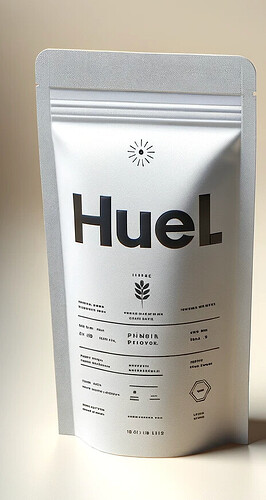Hey guys, just thought I’d throw in a few cents here.
The pot design confuses me as to the overall feel and, at least, the former ideology from Huel on focusing on savings, which is why the pouches and the reusable pots makes sense.
I just did a bit of math and each pot takes up 573cm^3.

I measured the volume of the contents by vacuumpacking it, volumen comes out to 200cm^3 on the dot using measurements from water displacement method.
So each meal pot “wastes” 373cm^3 for “air”, vs just vacuumpacking each meal in a bag.
Vacuumsealed food of course isn’t very visually appealing on a store shelf, but I would wager that those using the H&S pouches would be ok with this if it meant loosing the disposable pots and saving all that space on packaging, boxes etc. it would also eliminate the need for scooping as each pouch would be a meal, and ingredient ratio can be matched perfectly.
If you don’t want the vaccumpack look, it could be something like this:
Either way, I feel like continuing down the road with your users, that you have taught to make a meal in your reusable pots is a good thing, moving to individual pouches in terms of plastic use I would assume is a very small increase, compared to the current pouches, but hey, don’t take my word for it, let’s do some math:
Each pouch contains 7 meals of about 100grams each. They vary slightly from version to version, but I think we can agree on this average and the Chick’n and Katsu is 106g and 101g per pot respectively.
Each pouch is:
Height: 28cm
Width: 24cm
Plus additional 5cm in height used to create the “bottom” so it can stand.
It comes to: 33cm * 24cm * 2(sides) = 1584cm^2 for one pouch.
In comparison my vacuumpacked tester is 10cm * 10cm * 2, so 200cm^2.
7 meals vacuumpacked uses 1400cm^2 vs. the normal Huel packages, with a little room for optimization as I just tossed the ingredients in there, if you could fill the spaces with the powder, you could probably do better, but I digress.
So, vacuumpacking is slightly better in terms of plastic use compared to the regular Huel pouches with 200cm^2 plastic to 226cm^2(per meal, 7 in a pouch), but admittedly looks a lot worse, however probably would help in the conservation department, giving each meal a longer shelf life vs. pots or even just open pouches.
If we were to try and achieve a look for single servings as the big pouches, it would add rouhly 2cm extra in length, meaning 10 * 2 * 2 = 40cm^2 extra, bringing the total plastic use to 240cm^2 versus the 1584/7 = 226cm^2 from the regular pouches compared on a meal to meal basis, but I would assume that this more than makes up for it when it comes to volume savings - read on ![]()
Now let’s talk shipping and volume for the current pots.
Volume of each box of 8 pots is 11cm * 20cm * 40cm = 8800cm^3
8 pots volume is 573cm^3 * 8 = 4584cm^3 that means that 8800cm^3 - 4584cm^3 = 4216cm^3 in a box is air and in each of the pots there is, 372cm^3 * 8 = 2976cm^3 air. Combining that with the air in the box, that means that 2976cm^3 + 4216cm^3 = 7192cm^3 out of 8800cm^3 in each box is air or roughly 82%.
If we translate those numbers to a standard euro pallet, each pallet can hold roughly 168 boxes of product( L-1200mm, W-800mm and H-1600mm), with each box containing 8 pots. That’s roughly 1.536m^3 and of that 1.26m^3 is just air.
If we compare that to pouches, which I assume has a very low number when it comes to space wasted in packaging, let’s just try and say that the pouches are wasting 20% of the space 8800cm^3(box) / 240cm^3(volume of meal + 20% waste) * 168(boxes per pallet) = 6048 that’s meals per pallet vs. the current 168 boxes * 8 pots per box = 1344 meals. That’s huge! and definitely something I think should be considered.
The above is just rough numbers and perhaps you can’t pack the new proposed single serve pouches as closely to match above numbers, but they should be indicative that pots isn’t the way to go when trying to save cost and increase your transport performance. Also to note I am not calculating material thickness, so everything is just rough measurements of the outside packaging.
Doing it this way also gives you the option of doing samples without worrying about transport breakage as much.
rant over Thanks for listening.

